Unveiling the Enigmatic Hunter of the Antarctic: The Leopard Seal
Deep within the frigid, untamed waters of the Antarctic lies a creature of formidable power and captivating beauty: the leopard seal. Often portrayed as a fearsome predator, this magnificent marine mammal is much more than just a hunter. It is a vital component of the polar ecosystem, a marvel of evolution, and a testament to nature’s incredible adaptability. Join us on an exploration of Hydrurga leptonyx, delving into its life, its role, and its fascinating interactions with the world around it.
A Glimpse into the Leopard Seal’s World: Basic Facts
Before diving into the intricacies of its life, understanding the fundamental characteristics of the leopard seal provides a crucial foundation.
- Scientific Name: Hydrurga leptonyx
- Family: Phocidae (true seals)
- Size: These are large animals. Adult females, typically larger than males, can reach lengths of up to 3.5 meters (11.5 feet) and weigh over 600 kg (1,300 lbs).
- Lifespan: In the wild, leopard seals can live for an impressive 26 years, a testament to their resilience in a harsh environment.
- Appearance: Their sleek, torpedo-shaped bodies are perfectly adapted for aquatic life. The distinctive spotted coat, which gives them their common name, ranges from dark grey to black on the dorsal side, fading to lighter grey or white ventrally, adorned with irregular dark spots. They possess a remarkably large head, powerful jaws, long canine teeth, and unique tri-cusped molars.
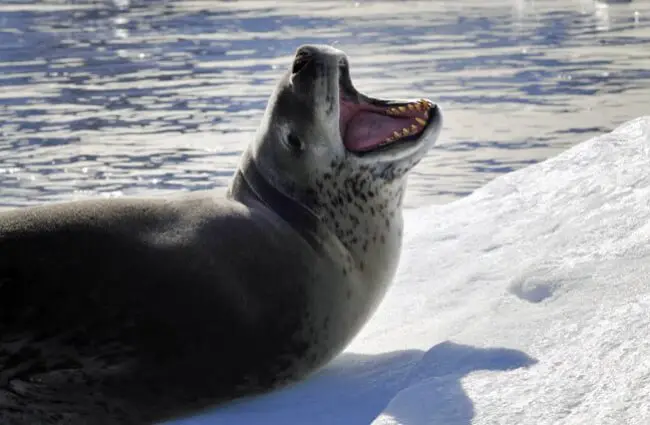
Where the Wild Things Are: Habitat and Distribution
The leopard seal is a true inhabitant of the Southern Ocean, perfectly adapted to its icy domain.
- Primary Range: Their distribution is circumpolar, meaning they are found all around the Antarctic continent.
- Preferred Environment: They are primarily associated with the pack ice zone, the dynamic region where sea ice forms and breaks up. This environment provides both hunting grounds and resting platforms. During the breeding season, they favor the more stable fast ice, which is anchored to land.
- Occasional Sightings: While predominantly Antarctic, younger or dispersing individuals can occasionally be found on sub-Antarctic islands such as South Georgia, Macquarie Island, and Heard Island. Rarely, they have even been sighted as far north as the coasts of Australia, New Zealand, and South America.
- Finding Them in the Wild: For the dedicated animal lover or aspiring zoologist hoping to observe these magnificent creatures, the best opportunities arise during expedition cruises to the Antarctic Peninsula, South Georgia, or other sub-Antarctic regions. Look for them hauled out on ice floes, often near penguin colonies, or swimming gracefully in the frigid waters. Always observe from a respectful and safe distance, typically from the deck of a vessel or a zodiac boat.
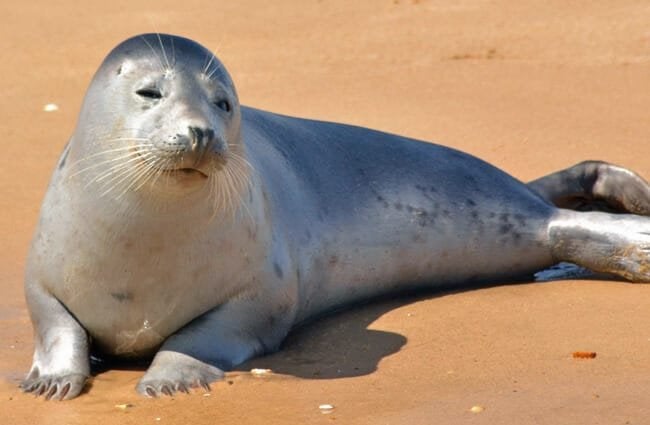
The Apex Predator’s Plate: Diet and Hunting Strategies
The leopard seal’s reputation as a formidable predator is well-earned, thanks to its diverse diet and cunning hunting techniques.
- Opportunistic Carnivore: This species is a highly adaptable and opportunistic predator, making it a dominant force in its ecosystem.
- Krill: Surprisingly, a significant portion of their diet, especially for younger seals, consists of Antarctic krill. Their unique tri-cusped molars are perfectly adapted to act like a sieve, filtering these small crustaceans from the water.
- Fish: Various Antarctic fish species also form an important part of their diet.
- Penguins: Leopard seals are famously known for preying on penguins, including Adélie, Chinstrap, and Gentoo species. They often ambush penguins at the water’s edge or pursue them with incredible speed and agility in the water.
- Other Seals: They are also known to hunt and kill smaller seals, particularly crabeater seals, which are abundant in their habitat. This makes them one of the few pinnipeds that regularly prey on other pinnipeds.
- Hunting Style: Leopard seals are solitary hunters, employing stealth and bursts of speed. Their incredible agility and powerful jaws make them exceptionally efficient at catching prey in the water.
Life’s Cycle in the Ice: Reproduction and Development
The reproductive cycle of the leopard seal is a testament to their solitary nature and the challenges of life in the Antarctic.
- Solitary Lifestyle: Leopard seals are largely solitary animals throughout most of the year, coming together primarily for breeding.
- Breeding Season: Mating and birthing typically occur during the Antarctic summer, generally spanning from November to February.
- Vocalizations: During the breeding season, males are known to produce complex and varied underwater vocalizations. These sounds are believed to play a role in territorial defense and attracting mates across the vast underwater soundscape.
- Birthing: Females give birth to a single pup, usually on the stable fast ice or isolated, large ice floes.
- Pup Care: Pups are born with a soft, woolly coat known as lanugo. They are nursed by their mothers for approximately one month. The mother’s milk is exceptionally rich, allowing the pup to grow rapidly and develop a crucial layer of blubber for insulation.
- Independence: Pups are weaned relatively quickly and must learn to hunt for themselves, a challenging transition in their harsh environment.
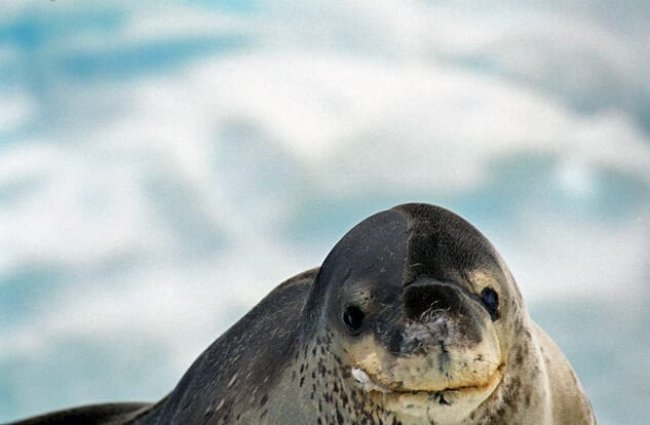
Evolutionary Journey: Adapting to the Antarctic Extreme
The leopard seal’s existence is a story of profound evolutionary adaptation, shaping it into the specialized predator it is today.
- True Seal Lineage: Leopard seals belong to the family Phocidae, commonly known as “true seals.” This group is distinguished by the absence of external ear flaps and their inability to rotate their hind flippers forward for efficient terrestrial locomotion, relying instead on undulating movements.
- Ancient Origins: Their ancestors likely evolved from terrestrial carnivores, gradually transitioning to an aquatic lifestyle over millions of years. This journey involved a series of remarkable morphological and physiological changes.
- Polar Specialization: Over eons, they developed specific adaptations that allowed them to thrive in the frigid Antarctic waters:
- Blubber: A thick, insulating layer of blubber is essential for thermoregulation in sub-zero temperatures and serves as a vital energy reserve.
- Streamlined Body: Their hydrodynamic, torpedo-shaped body minimizes drag, enabling efficient and swift movement through water.
- Specialized Dentition: The unique dental structure, featuring long, sharp canines for grasping and tearing prey, alongside tri-cusped molars for filtering krill, showcases their dietary versatility.
- Physiological Adaptations: They possess highly efficient oxygen utilization and diving reflexes, allowing them to undertake long, deep dives in pursuit of food.
The Ecosystem’s Enforcer: Ecological Role and Interactions
As an apex predator, the leopard seal plays an indispensable role in maintaining the delicate balance of the Antarctic ecosystem.
- Apex Predator: Occupying the top tier of the Antarctic food web, the leopard seal exerts significant influence over the populations of its prey species.
- Population Control: By preying on abundant species like penguins and crabeater seals, they help regulate these populations, preventing overgrazing of krill or overpopulation that could strain resources.
- Food Web Dynamics: Their presence and hunting activities influence the behavior, distribution, and overall health of other species, contributing to the complexity and resilience of the Antarctic marine ecosystem.
- Competition: While a dominant hunter, they also engage in competition with other large predators, such as orcas, for shared food resources, particularly krill and fish.
Leopard Seals and Humanity: Culture, Encounters, and Conservation
A Symbol of the Wild: Contribution to Human Culture
The leopard seal’s striking appearance and predatory prowess have cemented its place in human culture and scientific interest.
- Icon of the Antarctic: Featured prominently in nature documentaries, photography, and literature, the leopard seal has become an iconic symbol of the raw, untamed beauty and formidable wildlife of the Antarctic wilderness.
- Scientific Fascination: Their unique adaptations, complex behaviors, and crucial ecological role make them a subject of intense scientific study, contributing significantly to our understanding of polar ecosystems and marine biology.
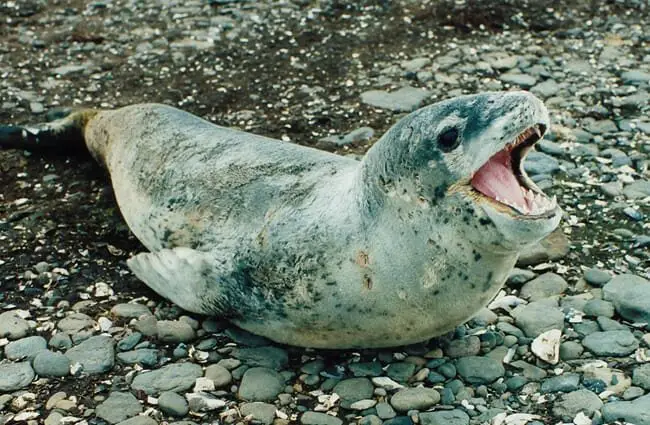
Encountering a Leopard Seal in the Wild: Safety First
While observing a leopard seal in its natural habitat is an unforgettable experience, it is paramount to remember that these are powerful wild animals that demand respect and caution.
Leopard seals are formidable predators. Any encounter in the wild requires strict adherence to safety protocols and maintaining a significant distance. Never approach or provoke a leopard seal.
- Maintain Distance: Always keep a substantial distance, ideally 15-20 meters (50-65 feet) or more, especially if the seal is hauled out on ice or near the water’s edge. This distance protects both you and the animal.
- Avoid Provocation: Do not make sudden movements, loud noises, or attempt to feed them. These actions can be perceived as a threat or an invitation, leading to unpredictable behavior.
- Observe from Afar: Use binoculars or telephoto lenses for observation and photography. This allows for close-up views without disturbing the animal.
- Report to Guides: If you are on an organized tour or expedition, always follow the instructions of your expedition leader or guides. Report any unusual or aggressive behavior immediately.
- Potential Danger: Though rare, there have been isolated incidents of leopard seals exhibiting aggressive behavior towards humans, including one fatal attack. This underscores the critical need for vigilance and respect for their wild nature. Never assume a wild animal is docile or harmless.
Caring for a Leopard Seal in Captivity: A Zookeeper’s Challenge
Leopard seals are exceptionally rare in captivity due to their specialized needs, large size, and predatory nature. Their care presents significant and unique challenges for zoological institutions.
- Habitat Requirements:
- Large, Cold Enclosure: A captive environment must replicate their natural Antarctic habitat. This necessitates a vast, deep pool of cold, filtered saltwater, maintained at precise temperatures.
- Haul-out Areas: Provision of ample land or ice platforms is crucial for resting, thermoregulation, and natural behaviors.
- Environmental Enrichment: Complex environments with varied substrates, toys, and opportunities for hunting simulation are essential to prevent boredom, encourage natural behaviors, and promote physical and mental well-being.
- Diet and Feeding:
- Specialized Diet: A carefully managed diet of high-quality, varied fish (e.g., mackerel, herring) and squid is required, supplemented with vitamins and minerals to ensure complete nutritional needs are met.
- Feeding Techniques: Feeding often involves “scatter feeding” or hiding food to encourage natural foraging behaviors and mental stimulation.
- Health and Monitoring:
- Regular Veterinary Checks: Routine examinations, blood tests, and continuous monitoring for any signs of illness or stress are paramount.
- Behavioral Observation: Close and consistent observation of their behavior can provide early indicators of health issues, stress, or social problems.
- What to Avoid:
- Stressful Environments: Loud noises, constant human presence, or inadequate space can severely impact a leopard seal’s welfare and health.
- Improper Diet: Malnutrition is a serious risk if their complex dietary needs are not precisely met.
- Direct Untrained Interaction: Due to their inherent predatory nature, direct interaction should only be undertaken by highly trained professionals following strict safety protocols and only when absolutely necessary for animal care.

Fascinating Facts About the Leopard Seal
Beyond their predatory reputation, leopard seals possess a host of intriguing characteristics.
- Speed Demons: These seals are incredibly agile and powerful in the water, capable of bursts of speed up to 40 km/h (25 mph).
- Deep Divers: Leopard seals are proficient divers, able to reach depths of over 300 meters (1,000 feet) and hold their breath for extended periods while hunting.
- Unique Dentition: Their dual-purpose teeth are a marvel of adaptation: long, sharp canines for grasping and tearing, and tri-cusped molars that interlock to filter krill from the water.
- Vocal Prowess: They are known for their complex and varied underwater vocalizations, which are particularly prominent during the breeding season and are thought to be crucial for communication.
- Solitary Hunters: Generally, leopard seals lead solitary lives, only coming together for breeding or when exceptionally large food sources are available.
- Camouflage Experts: Their spotted coats provide excellent camouflage, helping them blend seamlessly with the dappled light and shadows among ice floes and in the water, aiding both hunting and evasion.
- Long-Lived Predators: With a potential lifespan of up to 26 years, they are long-term, influential residents of the Antarctic ecosystem.
- Named for a Reason: Their common name is derived not only from their distinctive spotted coat but also from their fierce, predatory nature, reminiscent of the terrestrial leopard.
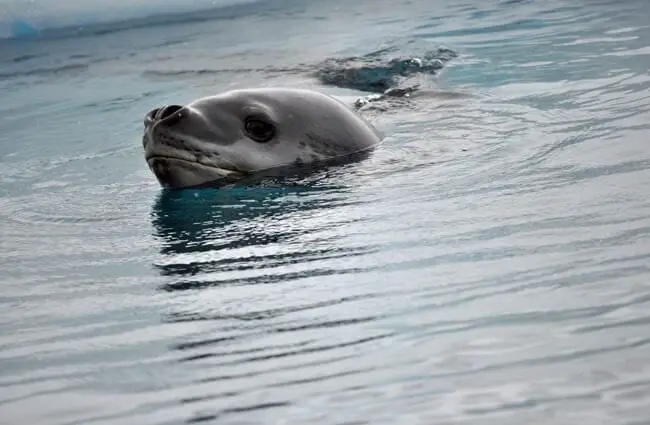
Conclusion: A Call to Appreciation
The leopard seal, with its formidable presence and vital role in the Antarctic ecosystem, stands as a testament to the power, adaptability, and intricate beauty of nature. Understanding and respecting this magnificent predator is crucial for anyone venturing into its icy domain or studying its complex life. From its unique evolutionary journey to its critical position in the food web, the leopard seal offers endless fascination for students, animal lovers, and aspiring zoologists alike. By appreciating its unique place in the world, we contribute to the ongoing efforts to protect the pristine Antarctic environment and all its incredible inhabitants, ensuring that this enigmatic hunter continues to thrive for generations to come.

![Red Angus Closeup of a beautiful Red Angus cowPhoto by: U.S. Department of Agriculture [pubic domain]https://creativecommons.org/licenses/by/2.0/](https://animals.net/wp-content/uploads/2020/03/Red-Angus-4-238x178.jpg)




![Red Angus Closeup of a beautiful Red Angus cowPhoto by: U.S. Department of Agriculture [pubic domain]https://creativecommons.org/licenses/by/2.0/](https://animals.net/wp-content/uploads/2020/03/Red-Angus-4-100x75.jpg)

